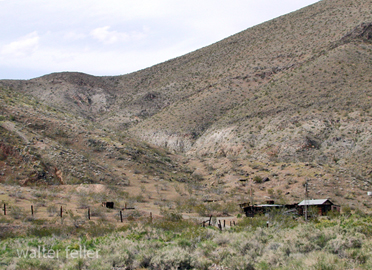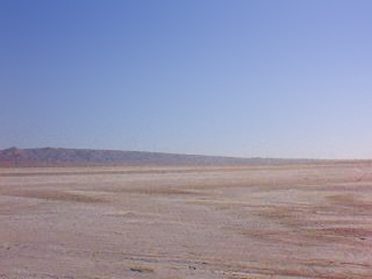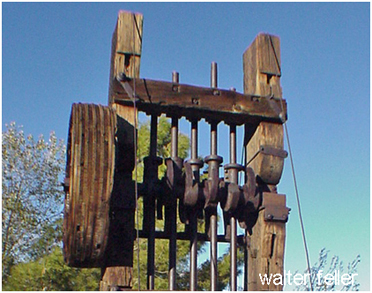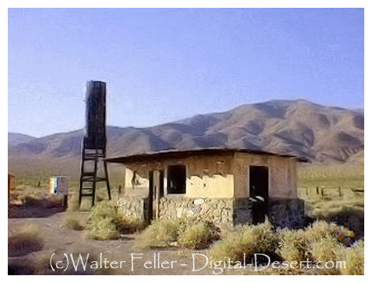El Paso Mining District
The first recorded mining activity in the El Paso Mountains predates the Sageland discoveries by a few years, but the majority of mining activity here took place in the early 1890s. A Manzanillo Mine was being operated in 1864 and 1865 by the Yarborough Gold and Silver Mining Company. Thirty five thousand dollars were invested in equipment and development resulting in 40 tons or ore being dug out and placed on dumps. Mining operations ended shortly after Mr. Yarborough was found murdered at Mesquite Springs (between Kane Dry Lake and Randsburg). Whether or not white bandits or Indians committed the slaying, Yarborough's death was enough to convince the miners that the area was too hostile and too remote from civilization to justify their continued presence.10
With silver discoveries in
Inyo and
San Bernardino
counties during the 1870s and 1880s drawing so much attention, prospectors overlooked the El Paso Mountains. It wasn't until the depression of the 1890s that men returned to the El Pasos in search of
gold. In
1893, two prospectors, Reed aid Benson, were prospecting in the Red Rock Canyon area. After moving east to the mouth of
Goler Canyon,
they found gold, in the gulches that now bear their names. Ramsey Cox, G. F. Mecham, Clyde Kuffel, Frank Yeager and Charley Shellman all filed claims at approximately the same time as Reed and Benson.11
On March 15, 1893, the Goler Mining District was established. John Wasserman acted as chairman that day with N.J. Ayers as secretary. After all the votes were counted, R.G. Willard became district recorder. The first claim recorded in the district was the Jackass Placer. One of the first men to capitalize on the new strike was Charlie Koehn. He had homesteaded some acreage adjacent to Kane Springs, only 12 miles from Goler Gulch, in 1892, intending to capture the trade running between
Tehachapi and the
Panamint Range. He
already had a profitable way station going, to which he added a post office on September 22, 1893, and began delivering letters to the local miners at 25 cents each. He also sold and hauled supplies, mining tools, food and drinks.12
By December, 1893, good gold diggings were discovered in Bonanza Gulch, east of
Red Rock Canyon. Over
$50,000 in gold had been taken out of the El Paso Mountains by year's end. During 1894 camps sprang up at Red Rock Canyon, Goler, and at Summit. In the fall of 1895, Eugene Garlock hauled an eight
stamp mill,
the first in this area, down from Tehachapi. This was located at Cow Wells due to the water supply and it's centralized location for various mining districts.
Garlock's small stamp mill was soon swamped with ore, and more mills, the McKernan, Kelly, Smith, Henry and Visalia, sprang up nearby. All but the Smith mill were steam driven. As business increased, the town felt it needed a constable. John Kelly was given the job. He reportedly had a policy of talking men into surrendering without the use of a weapon, as he reportedly disliked carrying a gun. The crossroads assembly of tents, frames, and adobe buildings soon became known by the name of the man whose mill brought in so much business. Cow Wells officially died on April 10, 1896, when Ida Kelly, the constable's wife, became postmistress of
Garlock. At it's heyday Garlock had at least two bars, two hotels, a stage depot, a laundry, doctor's and dentist's office and a school.13
The completion of the
Randsburg Railway
in early 1898 spelled the beginning of the end for Garlock's stamp mills,
and the town began to die. With the railroad complete more efficient mills were within reach and the small
amalgamation mills of Garlock lost most of their business. By 1900 most of Garlock's citizens had moved to
Randsburg. In
the twentieth century Garlock experienced two revivals. In 1911 the track laying crews of the
Southern Pacific briefly camped at abandoned Garlock while laying track from Keeler to Mojave. In the 1920s,
a J.D. Voss tried reopening the Apache Mine in Iron Canyon, while a salt company was busy at work
on
Koehn Dry Lake
and a Mesquite Springs prospect looked promising. Garlock awoke, reopening its post office,
a new store and a boardinghouse run by Sarah Slocum. But this respite was short lived, and the post office
closed on June 30, 1926.14
The El Paso Mountains are also the scene of one of Kern County's few coal boom towns. Coaldale was a small ...
Miscellaneous El Paso Mines
In 1939, a pumice deposit, now known as the Calsilco, was first worked northwest of Bonanza Gulch. The ...

Goler Gulch

Koehn Dry Lake

Stampmill (Randsburg Museum)

Garlock